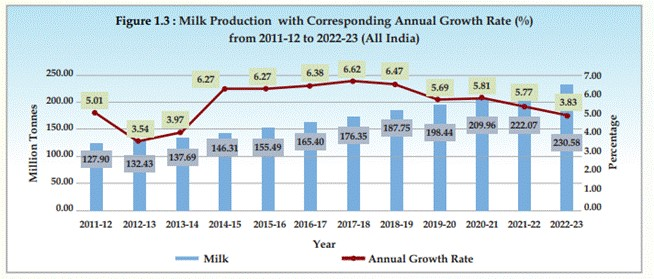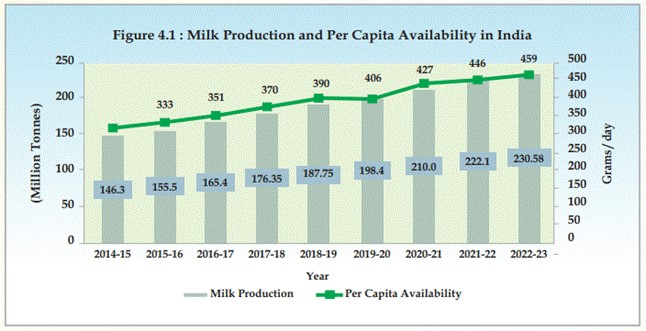Syllabus: GS3/Economy
Context
- For a long time, India has celebrated the incredible supply-side success of its White Revolution, initiated by Verghese Kurien. However, it is now crucial to shift focus to the demand side and ensure that milk reaches the most vulnerable populations.
About The White Revolution (Operation Flood)
- It was a transformative dairy development program initiated by India’s National Dairy Development Board (NDDB) in 1970.
- It was aimed to create a nationwide milk grid, linking producers across India to consumers in over 700 towns and cities.
- This effort not only increased milk production but also ensured fair prices for both producers and consumers by eliminating middlemen.
Phases of Operation Flood:
- Phase I (1970–1980): Financed by the sale of skimmed milk powder and butter oil donated by the European Economic Community through the World Food Program, this phase linked 18 premier milk sheds with major metropolitan cities, establishing a robust foundation for the dairy network.
- Phase II (1981–1985): Expanded the number of milk sheds from 18 to 136 and increased urban markets to 290.
- By the end of this phase, a self-sustaining system comprising 43,000 village cooperatives with 4.25 million milk producers was established.
- Phase III (1985–1996): Focused on consolidating the dairy cooperative movement, adding 30,000 new cooperatives to the existing network.
- Emphasis was placed on research and development in animal health and nutrition, further enhancing milk productivity.
Key Outcomes
- Globally India is 1st in Milk production with 230.58 million ton per annum (fiscal year 2022-23, an annual growth of 3.83%) and it is 25% of world production of milk followed by USA.
- The per capita availability of milk is around 459 grams/day in 2022-23.
- Top Milk-Producing States: Rajasthan, Uttar Pradesh, Madhya Pradesh, Gujarat, and Andhra Pradesh collectively account for over 50% of India’s total milk production.
- Livestock Population: The nation boasts a vast livestock population, including 303.76 million bovines and 74.26 million goats, underscoring the extensive foundation of its dairy sector.


Why Does Milk Matters in Nutrition?
- Milk is often called a ‘complete food’ because it contains essential nutrients necessary for growth, development, and immunity.
- Bone health: Rich in calcium and vitamin D, milk is crucial for preventing osteoporosis and stunted growth in children.
- Cognitive development: Omega-3 fatty acids and other nutrients in milk aid brain function and cognitive abilities in children.
- Immunity booster: The presence of vitamins A, B12, and zinc enhances immune response, reducing disease susceptibility.
- Protein source: It provides high-quality protein that supports muscle development and overall health.
- Research links milk consumption to lower odds of stunting, underweight, and anthropometric failure in Indian children aged between six months and five years.
- However, access to milk as vital food remains unequal across regions, socio-economic groups, and demographics.
Key Concerns & Challenges
- Disparity in Consumption: According to Household Consumer Expenditure Surveys (HCES) by the NSSO:
- Households in the top-income decile consume three to four times more milk per capita compared to those in the lowest-income decile.
- The poorest 30% of Indian households consume just 18% of India’s milk.
- Urban households consume about 30% more milk per capita than rural households, despite most milk being produced in rural areas.
- Barriers to Equitable Milk Access: According to National Family Health Survey (NFHS-5) data, milk consumption is significantly lower among poor households compared to affluent ones.
- Rural areas, especially in states like Bihar, Odisha, and West Bengal, report lower intake levels than dairy-rich states like Punjab, Haryana, and Gujarat.
- Income Disparities and Affordability: Poor families cannot afford milk regularly, making it a luxury rather than a staple.
- Dairy inflation has made milk costlier, with prices rising by 12–15% annually in recent years.
- Regional Production Disparities: Milk production is highly concentrated in a few states like Punjab, Haryana, and Maharashtra, while others face supply shortages.
- Infrastructure challenges in remote areas limit the availability of fresh milk.
- Cultural and Dietary Factors: In some parts of India, especially the eastern and northeastern regions, milk is not a traditional part of the diet, leading to lower consumption.
- Religious and ethical concerns influence dairy intake among some communities.
- Poor Cold Chain and Supply Logistics: Lack of proper refrigeration and storage facilities in rural areas leads to spoilage and wastage.
- Inconsistent supply chains limit milk distribution in underdeveloped regions.
Bridging the Milk Divide: Solutions and Strategies
- Strengthen Dairy Infrastructure in Low-Production Areas: Encouraging cooperative dairy farming can enhance milk production in states lagging behind.
- Investments in cold storage and transportation will improve milk distribution and reduce spoilage.
- Subsidized Milk Programs for Low-Income Families: The government can introduce milk fortification and ration-based schemes, ensuring access to affordable milk for underprivileged families.
- School meal programs should include milk to improve child nutrition.
- Encourage Alternative Dairy Products: Expanding the availability of low-cost dairy alternatives such as fortified milk powder and dairy-based nutritional supplements.
- Promoting locally available dairy substitutes in regions with lower milk consumption.
- Boost Awareness Through Nutrition Education: Awareness campaigns on the importance of milk in diet should target low-consumption regions.
- Schools and community centers can play a vital role in educating parents and children about the health benefits of dairy.
- Support Small and Marginal Dairy Farmers: Providing financial incentives, veterinary support, and better market linkages can empower small-scale dairy farmers.
- Encouraging sustainable dairy farming practices will enhance milk productivity while ensuring environmental sustainability.
Key Government Initiatives Supporting Dairy Development
- Programs like the Pradhan Mantri Poshan Shakti Nirman (POSHAN) and Integrated Child Development Services (ICDS) meals can be leveraged to provide milk or milk products.
- Collaborating with institutions such as the National Institute of Nutrition to integrate milk or milk products that align with socio-cultural preferences and tolerances is also crucial.
- Others key initiatives are:
- National Dairy Plan (NDP);
- Dairy Processing and Infrastructure Development Fund (DIDF);
- Rashtriya Gokul Mission (RGM);
- National Programme for Dairy Development (NPDD);
- Accredited Agent for Health and Extension of Livestock Production (A-HELP);
- Kisan Credit Cards (KCC) for Dairy Farmers etc.
Conclusion
- As India approaches the Union Budget 2025-26, addressing these disparities is essential for improved health outcomes for all.
- Ensuring equitable access to milk can significantly contribute to a nutritionally secure India, benefiting millions of vulnerable individuals and fostering overall well-being.
| Daily Mains Practice Question [Q] How can India effectively bridge the milk divide to ensure nutritional security for its most vulnerable populations, and what role should government policies and community initiatives play in this effort? |
Previous article
Semiconductor Sector Needs SOPs
Next article
Settling Sri Lanka’s Ethnic Problem